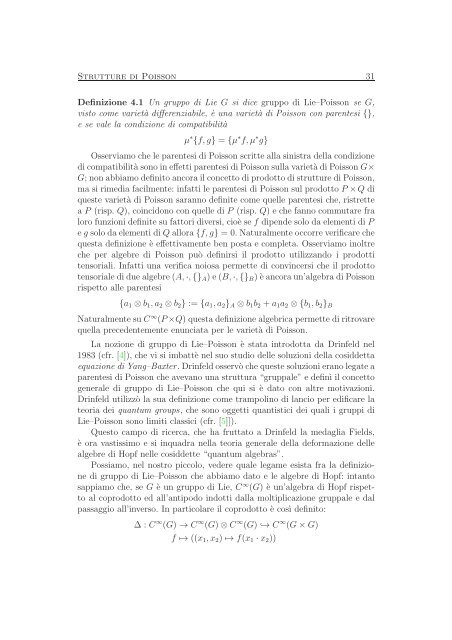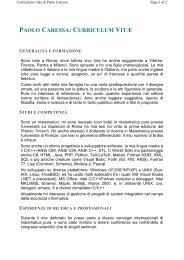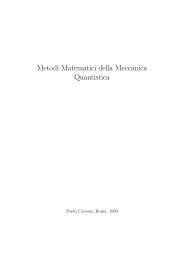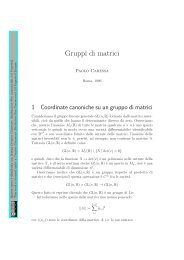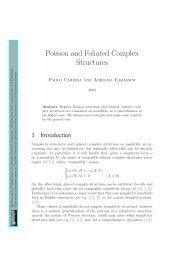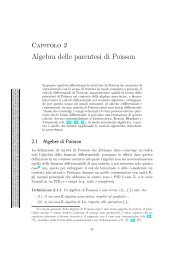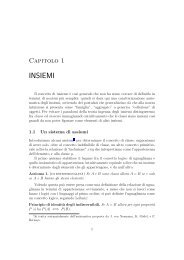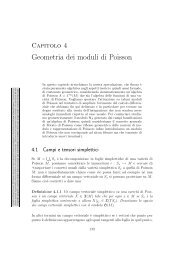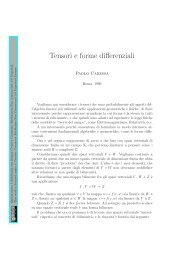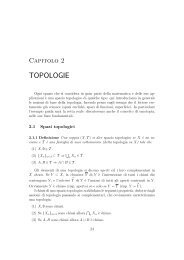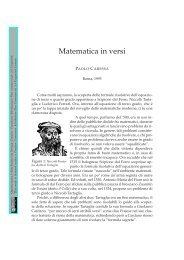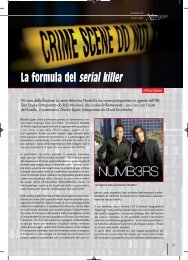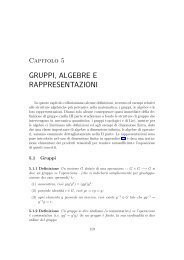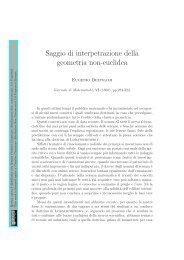Create successful ePaper yourself
Turn your PDF publications into a flip-book with our unique Google optimized e-Paper software.
<strong>Strutture</strong> <strong>di</strong> <strong>Poisson</strong> 31Definizione 4.1 Un gruppo <strong>di</strong> Lie G si <strong>di</strong>ce gruppo <strong>di</strong> Lie–<strong>Poisson</strong> se G,visto come varietà <strong>di</strong>fferenziabile, è una varietà <strong>di</strong> <strong>Poisson</strong> con parentesi {},e se vale la con<strong>di</strong>zione <strong>di</strong> compatibil<strong>it</strong>ൠ∗ {f,g} = {µ ∗ f,µ ∗ g}Osserviamo che le parentesi <strong>di</strong> <strong>Poisson</strong> scr<strong>it</strong>te alla sinistra della con<strong>di</strong>zione<strong>di</strong>compatibil<strong>it</strong>àsonoineffettiparentesi<strong>di</strong><strong>Poisson</strong>sullavarietà<strong>di</strong><strong>Poisson</strong>G×G;nonabbiamodefin<strong>it</strong>oancorailconcetto<strong>di</strong>prodotto<strong>di</strong>strutture<strong>di</strong><strong>Poisson</strong>,ma si rime<strong>di</strong>a facilmente: infatti le parentesi <strong>di</strong> <strong>Poisson</strong> sul prodotto P ×Q <strong>di</strong>queste varietà <strong>di</strong> <strong>Poisson</strong> saranno defin<strong>it</strong>e come quelle parentesi che, ristrettea P (risp. Q), coincidono con quelle <strong>di</strong> P (risp. Q) e che fanno commutare fraloro funzioni defin<strong>it</strong>e su fattori <strong>di</strong>versi, cioè se f <strong>di</strong>pende solo da elementi <strong>di</strong> Peg solodaelementi <strong>di</strong>Qallora{f,g} = 0.Naturalmenteoccorreverificarechequesta definizione è effettivamente ben posta e completa. Osserviamo inoltreche per algebre <strong>di</strong> <strong>Poisson</strong> può definirsi il prodotto utilizzando i prodott<strong>it</strong>ensoriali. Infatti una verifica noiosa permette <strong>di</strong> convincersi che il prodottotensoriale<strong>di</strong>duealgebre(A,·,{} A )e(B,·,{} B )èancoraun’algebra<strong>di</strong><strong>Poisson</strong>rispetto alle parentesi{a 1 ⊗b 1 ,a 2 ⊗b 2 } := {a 1 ,a 2 } A ⊗b 1 b 2 +a 1 a 2 ⊗{b 1 ,b 2 } BNaturalmentesuC ∞ (P×Q) questadefinizionealgebricapermette<strong>di</strong>r<strong>it</strong>rovarequella precedentemente enunciata per le varietà <strong>di</strong> <strong>Poisson</strong>.La nozione <strong>di</strong> gruppo <strong>di</strong> Lie–<strong>Poisson</strong> è stata introdotta da Drinfeld nel1983 (cfr. [4]), che vi si imbattè nel suo stu<strong>di</strong>o delle soluzioni della cosiddettaequazione <strong>di</strong> Yang–Baxter.Drinfeldosservòchequestesoluzionieranolegateaparentesi <strong>di</strong> <strong>Poisson</strong> che avevano una struttura “gruppale” e definì il concettogenerale <strong>di</strong> gruppo <strong>di</strong> Lie–<strong>Poisson</strong> che qui si è dato con altre motivazioni.Drinfeld utilizzò la sua definizione come trampolino <strong>di</strong> lancio per e<strong>di</strong>ficare lateoria dei quantum groups, che sono oggetti quantistici dei quali i gruppi <strong>di</strong>Lie–<strong>Poisson</strong> sono lim<strong>it</strong>i classici (cfr. [5]]).Questo campo <strong>di</strong> ricerca, che ha fruttato a Drinfeld la medaglia Fields,è ora vastissimo e si inquadra nella teoria generale della deformazione dellealgebre <strong>di</strong> Hopf nelle cosiddette “quantum algebras”.Possiamo, nel nostro piccolo, vedere quale legame esista fra la definizione<strong>di</strong> gruppo <strong>di</strong> Lie–<strong>Poisson</strong> che abbiamo dato e le algebre <strong>di</strong> Hopf: intantosappiamo che, se G è un gruppo <strong>di</strong> Lie, C ∞ (G) è un’algebra <strong>di</strong> Hopf rispettoal coprodotto ed all’antipodo indotti dalla moltiplicazione gruppale e dalpassaggio all’inverso. In particolare il coprodotto è così defin<strong>it</strong>o:∆ : C ∞ (G) → C ∞ (G)⊗C ∞ (G) ֒→ C ∞ (G×G)f ↦→ ((x 1 ,x 2 ) ↦→ f(x 1 ·x 2 ))


